Cosmetic Plastic Surgery Consumer Report: 1997-2010 and 2011 Cosmetic Plastic Surgery Statistics & Consumer Review
A Comprehensive Look at The Growth & Popularity of Cosmetic Plastic Surgery
A lot of the punditry class likes to bemoan how our society seems to be “obsessed” with good looks. The real problem is with using that word “obsession” when in reality wanting to look good is pretty much wired into our DNA. At our core level, we want to look our best to attract members of the opposite sex; its how our species is meant to survive!
In all practicality, looking good goes hand in hand with feeling good. It is also true that there are a handful of folks who have been blessed with exquisite genetics: they’re going to look good no matter what time of the day or night it is. For many of the rest of us, we need to help “nature” along with diet, exercise and yes, perhaps plastic surgery. Instead of considering plastic surgery as something only a vain person might indulge in, think of it as the perfect solution for adding the finishing touches on the “perfect you.”
Cosmetic Plastic Surgery Statistics for 2011 Reviewed
PlasticSurgery.org Reports: 13.8 Million Cosmetic Plastic Surgery Procedures Performed in 2011
The plastic surgery market continues to show significant growth – two years in a row. According to statistics released today by the American Society of Plastic Surgeons (ASPS), 13.8 million cosmetic plastic surgery procedures (both surgical and minimally-invasive) were performed in the United States in 2011, up 5 percent since 2010. In addition, 5.5 million reconstructive plastic surgery procedures were performed last year, up 5 percent.
“While the rate of economic recovery in the U.S. is still uncertain, 2011 proved to be a good year for plastic surgery,” said ASPS President Malcolm Z. Roth, MD. “Consumer confidence was up, auto sales rose 10 percent, so it is not surprising that we would also see increased demand for plastic surgery procedures.”
Cosmetic surgical procedures increased 2 percent, with nearly 1.6 million procedures in 2011. The top five surgical procedures were:
• Breast augmentation (307,000 procedures, up 4 percent)
• Nose reshaping (244,000 procedures, down 3 percent)
• Liposuction (205,000 procedures, up 1 percent)
• Eyelid surgery (196,000 procedures, down 6 percent)
• Facelift (119,000 procedures, up 5 percent)
Facelifts are among the top five cosmetic surgical procedures for the first time since 2004, replacing tummy tucks. Interestingly, a procedure popular with men, chin augmentation, nearly doubled in 2011, with 21,000 procedures performed, up 71 percent. Lip augmentation also rose significantly – up 49 percent, with more than 25,000 procedures performed.
“We are seeing notable increases in surgical procedures, such as facelifts, that reflect the demands of an aging boomer population,” said Dr. Roth. “However, the overall growth in cosmetic procedures is being primarily driven by a substantial rise in minimally-invasive procedures.”
Cosmetic minimally-invasive procedures increased 6 percent, with nearly 12.2 million procedures in 2011. The top five minimally-invasive procedures were:
• Botulinum toxin type A (5.7 million procedures, up 5 percent)
• Soft tissue fillers (1.9 million procedures, up 7 percent)
• Chemical peel (1.1 million procedures, down 3 percent)
• Laser hair removal (1.1 million procedures, up 15 percent)
• Microdermabrasion (900,000 procedures, up 9 percent)
Soft tissue fillers like hyaluronic acid (Restylane®, Juvederm Ultra®, etc.), calcium hydroxylapatite (Radiesse®), and fat injections experienced some of the largest growth in the minimally-invasive market during 2011. More than 1.3 million hylauronic acid procedures were performed in 2011, up 9 percent; 286,000 calcium hydroxylapatite procedures, up 36 percent; and 68,000 fat injections, up 19 percent.
Reconstructive plastic surgery, which improves function and appearance to abnormal structures, increased 5 percent in 2011. The top five reconstructive procedures were:
• Tumor removal (4.2 million, up 3 percent)
• Laceration repair (303,000, down 15 percent)
• Maxillofacial surgery (195,000, up 125 percent)
• Scar revision (175,000, up 9 percent)
• Hand surgery (120,000, up 13 percent)
Breast reconstruction rates continue to rise, with more than 96,000 procedures performed last year, up 3 percent since 2010.
“While insurance coverage for breast reconstruction is mandated by law, continued strides to provide coverage for other reconstructive procedures has contributed, in part, to the sizable gain that we are seeing with these procedures,” said Dr. Roth. “Reconstructive surgery is a critical pillar of the specialty, and it is encouraging to see that increasing numbers of patients entrust board-certified plastic surgeons to reconstruct their bodies after disease or trauma.”
ASPS members can report procedural information through the first online national database for plastic surgery procedures, Tracking Operations and Outcome for Plastic Surgeons (TOPS). This data, combined with the annual survey sent to American Board of Medical Specialties certified physicians most likely to perform these procedures, results in the most comprehensive census on plastic surgery.
To view the 2011 National Clearinghouse of Plastic Surgery Statistics report, visit www.plasticsurgery.org/2011-statistics. Visitors can also find information about procedures and referrals to ASPS Member Surgeons.
More Interesting Cosmetic Plastic Surgery Statistics for 2010 and Earlier by CosmeticPlasticSurgeryStatistics.com
The top five surgical procedures were:
- Breast Augmentation (318,123)
- Liposuction (289,016)
- Eyelid surgery (152,123)
- Abdominoplasty (144,929)
- Breast Reduction (138,152)
Cosmetic minimally-invasive procedures decreased almost 9 percent, with nearly 8 million procedures in 2010. Nonsurgical procedures accounted for 83% of the total number of procedures performed representing 39% of total expenditures. The top five minimally-invasive procedures were:
- Botulinum Toxin Type A (2,437,165 procedures)
- Hyaluronic acid (1,315,121 procedures)
- Laser hair removal (936,270 procedures)
- Laser skin resurfacing (562,706 procedures)
- Chemical peel (493,896 procedures)
Women had almost 8.6 million cosmetic procedures, 92 % of the total. The number of cosmetic procedures for women increased over 164% from 1997. The top five surgical procedures for women were: breast augmentation, liposuction, breast reduction, abdominoplasty, and eyelid surgery.
Men had over 750,000 cosmetic procedures, 8% of the total. The number of cosmetic procedures for men increased over 88% from 1997. The top five surgical procedures for men were: liposuction, rhinoplasty, eyelid surgery, breast reduction to treat enlarged male breast, and cosmetic ear surgery.
Americans spent nearly $10.7 billion on cosmetic procedures in 2010. Of that total almost $6.6 billion was spent on surgical procedures; $1.9 billion was spent on injectable procedures; $1.8 billion was spent on skin rejuvenation procedures; and almost $500 million was spent on other nonsurgical procedures including laser hair removal and laser treatment of leg veins.
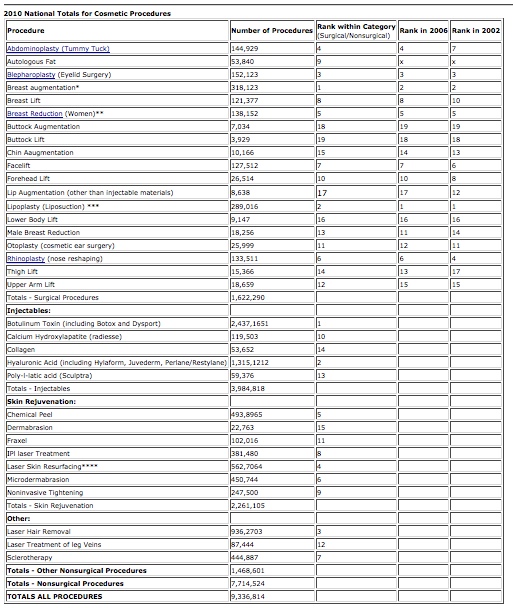
* 38.0% of these procedures used saline implants and 62.0% used silicone implants.
** Breast Reduction may be covered by insurance, depending on terms of the policy and individual patient factors.
*** 21.3% of these procedures were Ultrasound-Assisted Lipoplasty (UAL).
**** 36.0% of these procedures were performed with ablative lasers and 64.0% were performed with nonablative lasers. Due to an insufficient sample of physicians who perform the following procedures, these items have been excluded from the results: cheek implants; Hair transplantation; Injection lipolysis; laser lipolysis; and Polymethyl methacrylate.
x = rankings for this procedure in prior years is not available. Prior year rankings have been adjusted for equal comparison.
Please Note: The Aesthetic Society Statistics Survey only asks how many procedures the surgeon being surveyed has performed. The number reported may not include all of the nonsurgical procedures being performed in a surgeon’s office by physician assistants and nurse injectors. Future surveys will include these groups for injectable procedures.
Quick Facts: Highlights of the ASAPS 2010 Statistics on Cosmetic Surgery:
- Surgical procedures accounted for 17% of the total number of procedures and 62% of total expenditures with nonsurgical procedures making up 83% of the total number of procedures and 38% of total expenditures.
- From 2009-2010, there was almost a 9% increase in the total number of cosmetic surgical procedures, with over 1.6 million surgical procedure this year.
- Since 1997, there has been over 155% increase in the total number of cosmetic procedures. Surgical procedures increased by more than 71%, and nonsurgical procedures increased by 228%.
- The top five cosmetic surgical procedures in 2010 were: breast augmentation (318,123 procedures); liposuction (289,016 procedures); eyelid surgery (152,123 procedures); abdominoplasty (144,929 procedures); breast reduction (138,152 procedures).
- The top five nonsurgical cosmetic procedures in 2010 were: Botulinum Toxin Type A (2,437,165 procedures); hyaluronic acid (1,315,121 procedures); laser hair removal (936,270 procedures); laser skin resurfacing (562,706 procedures); chemical peel (493,896 procedures).
- Women had almost 8.6 million cosmetic procedures, 92% of the total. The number of cosmetic procedures for women increased over 164% from 1997.
- The top five surgical procedures for women were: breast augmentation, liposuction, breast reduction, abdominoplasty, and eyelid surgery.
- Men had over 750,000 cosmetic procedures, 8% of the total. The number of cosmetic procedures for men increased over 88% from 1997.
- The top five surgical procedures for men were: liposuction, rhinoplasty, eyelid surgery, breast reduction to treat enlarged male breast, and cosmetic ear surgery.
- Americans spent nearly $10.7 billion on cosmetic procedures in 2010. Of that total almost $6.6 billion was spent on surgical procedures; $1.9 billion was spent on injectable procedures; $1.8 billion was spent on skin rejuvenation procedures; and almost $500 million was spent on other nonsurgical procedures including laser hair removal and laser treatment of leg veins.
- People age 35-50 had the most procedures – more than 4 million and 44% of the total. People age 19-34 had 20% of procedures; age 51-64 had 28%; age 65 and over had 7%; and age 18 and younger had 1.3%.
- The most common procedures for age 35-50 were: Botulinum Toxin Type A, hyaluronic aAcid, laser hair removal, sclerotherapy, laser skin resurfacing.
- Racial and ethnic minorities, as of last year, had approximately 19% of all cosmetic procedures: Hispanics, 8%; African-Americans, 6%; Asians, 4%; and other non-Caucasians, 1%.
- Where cosmetic surgeries were performed: office facility, 56%; free-standing surgicenter, 24%; and hospital, 19%.
- Of the doctors surveyed 75% reported they do not offer “spa” services (e.g. wraps, facials, massages) in conjunction with their medical practices. 88% of the doctors do not work in conjunction with medical spas where nonsurgical procedures, such as injections and laser procedures are performed.
Figures may not add exactly to totals and percentages may not equal 100% due to rounding.
Source: American Society for Aesthetic Plastic Surgery
Cosmetic Plastic Surgery Graphs Showcasing Clear Growth from 1997 to 2010
Surgical and Non-Surgical Cosmetic Plastic Surgery Procedures: 1997 to 2010 Totals
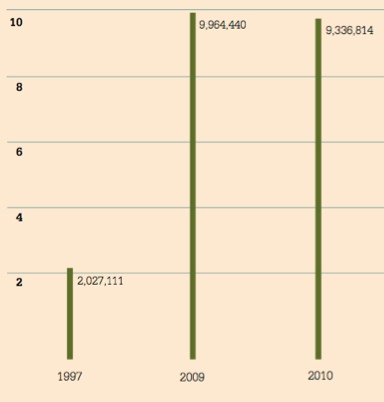
Breast Augmentation Procedures Performed for Women 18 and Under in 2010
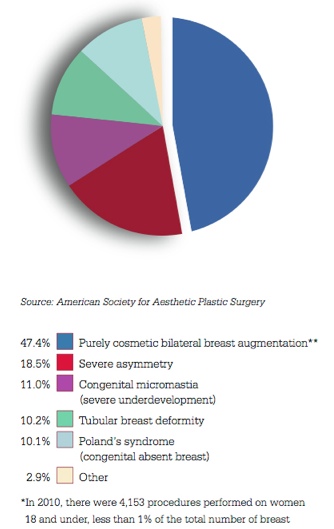
Percent of Total Cosmetic Plastic Surgery Procedures in 2010 According to Race and Ethnicity
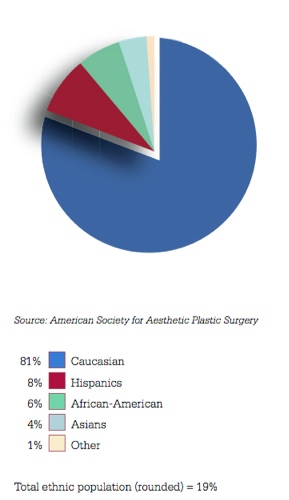
Top 5 Surgical Procedures in 2010 by Cosmetic Plastic Surgery Procedure Type
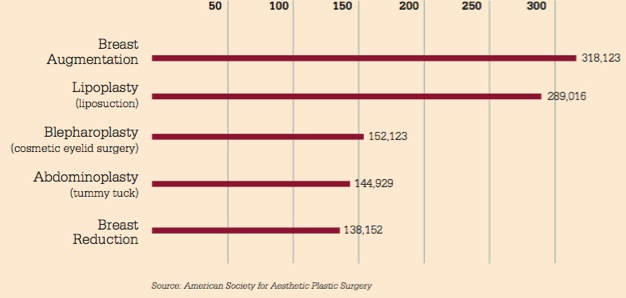
Top 5 Surgical Cosmetic Procedures in 2010 by Cosmetic Plastic Surgery Procedure Type
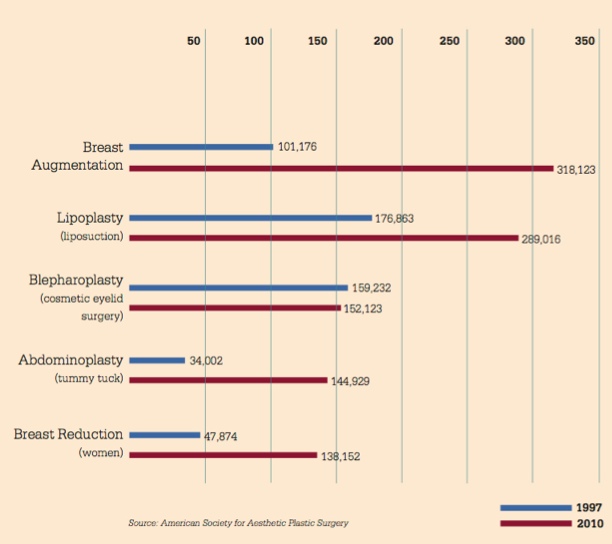
Top 5 Cosmetic Surgeries for Men in 2010 by Cosmetic Plastic Surgery Procedure Type
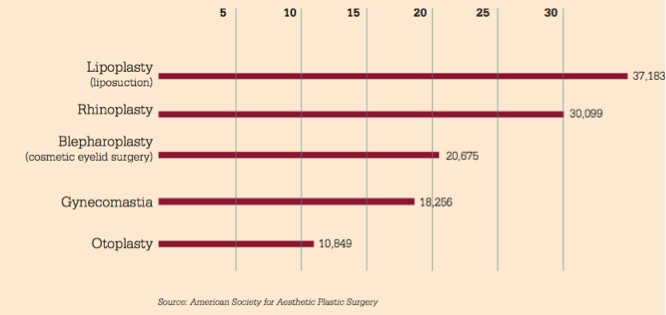
Top 5 Non-Surgical Procedures in 2010 by Non-Surgical Cosmetic Procedure Type
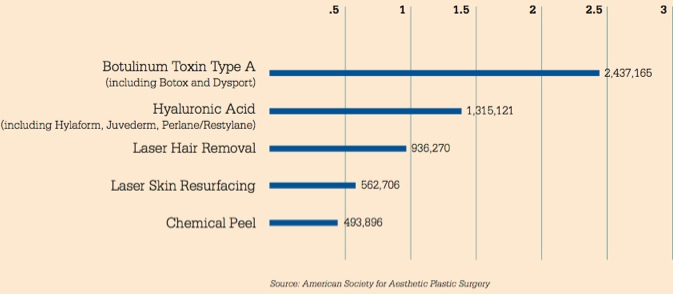
Quick Thoughts After Reviewing This Cosmetic Plastic Surgery Data:
> This industry is proving to be recession proof and doesn’t seem to be slowing down. Every time someone get’s work for the first time and experiences positive results they become a word of mouth promoter and walking testimonial showcasing the results of this continually improving art form.
> Reality TV and Hollywood are successfully influencing the status quo of what a man’s gut should look like… The growth of “Liposuction” surgery amongst men is clearly evident.
> We hear a lot about the “Brazilian Butt Workout” and how J-Lo and Kim Kardashian have spawned a wave of “Butt Augmentation” consultations for Women young and old but it’s clear as day that “Bigger Breasts” are still the priority amongst women.
> Facial Rejuvenation and Facial Plastic Surgery will continue to grow aggressively as the techniques and solutions improve and become “less scary” or “intrusive”. A great facelift can take off as many as 6-8 years, depending on the extent of the procedure.
Here are 5 Questions to Ask Before You Have Cosmetic Plastic Surgery from Health.com that we found useful:
Question One: “What Are Your Qualifications?”
Importance: Look for a surgeon is who is certified by the American Board of Plastic Surgery. Also, look for a surgeon who is a specialist in the procedure you’re looking to get.
Question Two: “How Often Have you Performed This Procedure?”
Importance: Make sure the surgeon you’re talking to is experienced. You don’t want someone working on you who claims he can do what you need based on his Website information alone… These days a brand new doctor who can afford to pay for traffic or advertising from Google can appear to be an expert in order to get your business. Make sure you see before and after images and request testimonials from patients who’ve had the same procedure.
Question Three: “What are the Potential Risks?”
Importance: You do not want your surgeon telling you there is nothing to worry about or that he can promise a risk-free surgery. With any surgery there are always risks.. You want a surgeon who can talk to you about them and what precautions they take to minimize these risks. This is an adult conversation that should not be uncomfortable or avoided.
Question Four: “Where Will The Surgery Take Place?”
Importance: You should be operated on in a hospital or accredited surgical facility (a.k.a. an outpatient or ambulatory surgery center), not a medi-spa or regular, unaccredited doctor’s office. Accreditation means that the facility adheres to strict safety and quality standards. (You can double-check accreditation at aaasf.org, aaahc.org, or qualitycheck.org)
Question Five: “Do You Have Hospital Privileges?”
Importance: If something goes wrong and you need to be admitted to a hospital you want your doc to keep treating you himself, rather than turning you over to another doctor with no prior knowledge of your case.
General Information About Cosmetic Plastic Surgery to Review and Consider:
What Are Your Cosmetic Plastic Surgery Goals?
Everyone, even the top fashion models, have something about their physical appearance that they would like to change. Whether that is through breast augmentation, tummy tucks, liposuction or wrinkle removal plastic surgery can offer up the possibility of rectifying those imperfections. During your initial consultation with a board certified plastic surgeon you’ll be present with several options as to what to expect with a cosmetic procedure. This is especially true if you are thinking about such things as breast enlargement or rhinoplasty to smooth out your nose. With these types of procedures you might have the opportunity to assess a virtual “before and after” appearance. While it might not be exact, these after images will closely resemble what you will look like. Ask yourself if this is the look you’re going for. If so, then the next step should be to weigh all the pros and cons associated with plastic surgery.
Pros of Cosmetic Plastic Surgery
Naturally, improving the shape of your body or reducing the impact of aging to your face would be top of the list of the benefits of a cosmetic procedure. Along with those improvements can come the kind of confidence that could enhance your relationships and your workplace standing. People who feel good about themselves tend to be more outgoing. This translates into becoming more socially active as well as confident enough to ask the boss for that long overdue raise!
Thanks to advancements in the field, many plastic surgery procedures have been developed to minimize the invasive nature of the operation and post-op pain. There will still be a regulated recovery period but most pain and swelling can be managed by following the guidelines of your cosmetic surgeon. Today wide arrays of available procedures are classified as “out-patient.”
Risks of Cosmetic Plastic Surgery
To engage in plastic surgery is to alter your body. In many ways, there might be no “going back.” As with any type of medical procedure there are risks associated to plastic surgery, especially if your procedure will require anesthesia. You’ll want to make sure you review all aspects of your potential procedure with your doctor. Let him walk you through the worst case scenario that way you’ll be making a fully informed decision about moving forward.
As you consider changing your outward appearance you should also give an equal amount of introspection to your inner emotional needs. Just because plastic surgery might provide you with the kind of body shape you have always desired doesn’t automatically guarantee you’ll feel completely better about yourself. Overall, the vast majority of cosmetic surgery patients are completely satisfied with their procedures but it might take a bit of an adjustment period for you to get used to the “new you.”
***If you have questions about a non-surgical or surgical cosmetic plastic surgery procedure and you’d like to set up a consultation with Dr. Pinsky of Palm Beach Gardens, FL please feel free to complete a request for consultation form or call us directly to speak with one of our patient coordinators at: 1-866-881-8001
Look through Cosmetic Plastic Surgery Before and After Galleries by Dr. Pinsky: